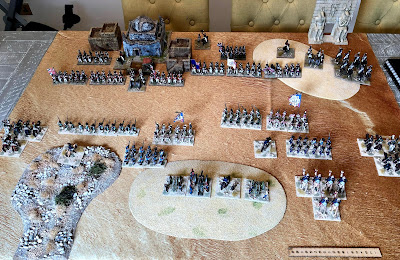This new book on the British intervention in the Egyptian campaign by Stuart Reid is revisiting an old friend for me. In 2008, I ran three display games for GDWS at wargame shows that year on the theme of Napoleon in Egypt in 28mm. It involved a lot of work but was great fun and was well-received. Charles Grant even kindly signed my copy of his then recently published two-volume campaign study at one of the shows. In 2010 we did a follow up with the 1801 Battle of Alexandria.
Although many are quite old, there is no shortage of books on the campaign, and even Charles Grant and Paul Strathern (Napoleon in Egypt) are now 15 years old. Most books give the post-Napoleon stage and the British intervention less attention, or in some cases, it's just an afterthought. So, this book, by an author who has written extensively about the British army of the period, is very welcome. Hopefully, it will bring an interesting campaign to a new generation.
The British commander of the expedition was General Abercromby. Reid is perhaps less sympathetic than the 2019 biography by Carole Divall. He was killed quite early in the campaign and replaced by his second in command, John Hely Hutchinson, who was arguably just as ill-equipped for the job. Described as 'a slovenly, unsociable man with a filthy temper'. Reid argues that the real stars of the campaign were the brigade commanders, which included Sir John Moore.
This book pays more attention than most to the Ottoman Turkish forces that supported the British. These included the usual irregular rabble but also the disciplined regular infantry, the Nizan I-Cedid. The Turks also provided additional gunboats and other small craft that were essential to the campaign. The cavalry was particularly useful given most of the two British cavalry regiments arrived without horses. The Turks also defeated the French under Reynier at Belbeis by restraining their usual mad charge at the French squares. British advisors showed them a better tactic of sniping at the squares and using their artillery more effectively.
The French army was one of the most colourful of the Revolutionary and Napoleonic wars, which made them a joy to collect. No rank after rank of blue-coated infantry here. My personal favourite is the Regiment des Dromadaires.
There are several tactical points of interest that Reid highlights. For example, at the Battle of Alexandria, the British line did not always form a square when faced with cavalry. Stewart's Brigade fought off several charges by French cavalry, causing 25% casualties. Later in the campaign, the French outside Alexandria formed up in line, being attacked by British infantry in battalion columns covered by a heavy skirmish line. The British also had a range of colourful foreign regiments, including the Corsican Rangers, Hompesch' Hussars, Chasseurs Britanniques and the Regiment de Watteville.
Whatever Abercromby's shortfalls may have been, he can be credited for preparing his army in a way that addressed some of the earlier disasters. Reid argues that this proved to be a transitional moment in the history of the British Army, 'as a shambolically inefficient army began to flower into what would very soon be described (by the Duke of Wellington no less) as "probably the most complete machine for its numbers now existing in Europe"'.
The book includes a complete narrative of the campaign covering all the major actions. There are also extensive appendices covering the opposing forces and some colour plates. The wargamer will probably also want to buy Charles Grant's books for the colour plates and uniform details, but this is a better narrative history.
So, onto the tabletop. My current ruleset of choice for tactical games is Lasalle2. Here we have two brigades a side with the French attacking the British line in the traditional manner.
My plan was to pin the British right and concentrate my main attack on the left with artillery and cavalry support. Not to mention the Regiment des Dromadaires!
 |
| The Dragoons had swept away the British light dragoons and caught the British in line - ouch! |
This battle plan was just as well as our daughter's cat is staying with us a couple of days, and he decided to park himself between the two lines.
The French routed the British 2nd Brigade and swung around the flank, forcing the British to withdraw.
I enjoyed getting these figures back on the table. Time to dust down the Ottomans next!






No comments:
Post a Comment